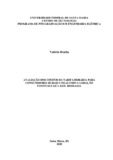| dc.creator | Braida, Valeria | |
| dc.date.accessioned | 2021-10-20T12:08:06Z | |
| dc.date.available | 2021-10-20T12:08:06Z | |
| dc.date.issued | 2020-02-18 | |
| dc.identifier.uri | http://repositorio.ufsm.br/handle/1/22478 | |
| dc.description.abstract | Low Voltage (LV) consumers are considered the most responsible for loading the electrical systems during peak hours by, increasing the expansion costs of the distribution system. To stimulate the efficient use of electricity, the National Electric Energy Agency (ANEEL) established a new tariff modality for low voltage consumers, the White Tariff, effective since January 2018. The White Tariff is an hourly rate with three different time schedules throughout a day. In addition to this new tariff modality, ANEEL established the conditions for access to distributed micro-generation and mini-generation since 2012 through the Normative Resolution (RN) No. 482, to encourage the inclusion of Distributed Generation (DG) in Low Voltage consumers. In this sense, the proposal of this dissertation is to present a study of the adhesion effects to the White Tariff for rural consumers using simultaneously photovoltaic and/or biomass energy sources, considering for this analysis the current energy tariffs and the typical load curves for each consumption range. The program Hybrid Optimization Model for Electric Renewables (HOMER) was used to perform the economic feasibility simulations and analysis and to make decisions in adhering or not to the White Tariff in conjunction with DG. Through this analysis, it was hoped to obtain an overview of the advantages and disadvantages that this new charging system compared to the conventional charging for rural consumers and the concessionaire, as well as the consumer's viability to join or not the renewable energy sources for insertion in distributed generation. Several configurations were evaluated under economic aspects and for different regions (Region South, Region Northeast and Northern Hemisphere). The results made it possible to identify which consumption ranges and regions would benefit the most through joining the White Tariff in conjunction with GD. It was concluded that out of the fifteen scenarios analyzed in only nine of these, the use of the Hourly Rate in conjunction with the DG became economically viable, with two scenarios for the South Region, two others for the Northeast Region and five scenarios for the Province of Ontario. | eng |
| dc.language | por | por |
| dc.publisher | Universidade Federal de Santa Maria | por |
| dc.rights | Attribution-NonCommercial-NoDerivatives 4.0 International | * |
| dc.rights.uri | http://creativecommons.org/licenses/by-nc-nd/4.0/ | * |
| dc.subject | Tarifa horária branca | por |
| dc.subject | Consumidores rurais | por |
| dc.subject | Geração distribuída | por |
| dc.subject | Fotovoltaica | por |
| dc.subject | Biomassa | por |
| dc.subject | White time tariff | eng |
| dc.subject | Rural consumers | eng |
| dc.subject | Distributed generation | eng |
| dc.subject | Photovoltaic | eng |
| dc.subject | Biomass | eng |
| dc.title | Avaliação dos efeitos da tarifa horária para consumidores rurais utilizando a geração fotovoltaica e/ou biomassa | por |
| dc.title.alternative | Evaluation of hour rate effects for rural consumers using generation photovoltaic and/or biomass | eng |
| dc.type | Dissertação | por |
| dc.description.resumo | Os consumidores em Baixa Tensão (BT) são considerados os maiores responsáveis pelo carregamento do sistema elétrico no horário de ponta, acarretando custos na expansão dos sistemas de distribuição. Buscando estimular o uso eficiente da energia elétrica, a Agência Nacional de Energia Elétrica (ANEEL) estabeleceu uma nova modalidade tarifária aos consumidores em BT, a Tarifa Branca, em vigor desde janeiro de 2018. A Tarifa Branca é uma Tarifa Horária com três postos tarifários diferentes ao longo do dia. Além dessa nova modalidade tarifária, a ANEEL estabeleceu as condições para o acesso a microgeração e minigeração distribuída desde 2012 por meio da Resolução Normativa (RN) nº 482, buscando incentivar a inserção de Geração Distribuída (GD) em consumidores de BT. Neste sentido, a proposta desta dissertação é apresentar um estudo dos efeitos desta adesão à Tarifa Branca para consumidores rurais utilizando em conjunto fontes de energia fotovoltaica e/ou da biomassa, considerando para tal análise as tarifas de energia vigentes e as curvas de carga típicas para cada faixa de consumo. O programa Hybrid Optimization Model for Electric Renewables (HOMER) foi utilizado para realizar as simulações auxiliando na análise econômica e tomada de decisão quanto a adesão ou não à Tarifa Branca em conjunto com a GD. Diversas configurações foram avaliadas sob aspecto econômico e para diferentes regiões (Região Sul, Região Nordeste e Hemisfério Norte). Os resultados permitiram identificar quais as faixas de consumo e regiões que mais se beneficiariam com a adesão à Tarifa Horária em conjunto com a GD. Concluiu-se que dos quinze cenários analisados em apenas nove destes a utilização da Tarifa Horária em conjunto com a GD se tornou economicamente viável, sendo dois cenários para a Região Sul, outros dois para a Região Nordeste e cinco cenários para a Província de Ontário. | por |
| dc.contributor.advisor1 | Farret, Felix Alberto | |
| dc.contributor.advisor1Lattes | http://lattes.cnpq.br/5783619992936443 | por |
| dc.contributor.referee1 | Gonzatti, Frank | |
| dc.contributor.referee2 | Campos, Maurício de | |
| dc.creator.Lattes | http://lattes.cnpq.br/0758839334595056 | por |
| dc.publisher.country | Brasil | por |
| dc.publisher.department | Engenharia Elétrica | por |
| dc.publisher.initials | UFSM | por |
| dc.publisher.program | Programa de Pós-Graduação em Engenharia Elétrica | por |
| dc.subject.cnpq | CNPQ::ENGENHARIAS::ENGENHARIA ELETRICA | por |
| dc.publisher.unidade | Centro de Tecnologia | por |



